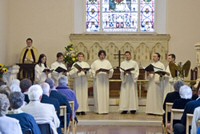

|
|
| Musical Musings: Miscellaneous |
The West's One True MusicThis article, which appeared in the July 2009 edition of Columbia Magazine, the monthly journal of the Knights of Columbus, is reprinted with the kind permission of the author.
The great achievement of Roman Catholicism is that it attined a cultural identity that is supranational and, ultimately, intercontinental. Certainly, the Roman liturgy was well disposed to its sweeping mission. Its portability combined with the natural Roman indifference to race or tribe. This was, after all, the empire that extended citizenship to all its far-flung provinces. Borne by the zeal of early missionaries, it yielded a confederacy of Celt, Goth, Frank and Roman peoples under one Latin rite — an accomplishment known to history as Christendom. It is important to note that the Roman rite, at the peak of its development in the Middle Ages, was not a monolith. Rather, it weaved itself into cultures and was richly embroidered by local cusoms. Not the least of these contributions was music. As the rite progressed into the far reaches of Europe, it collected — really, assumed — the musical accents of its new adherents, harmonizing new voices with old and adopting a symphony of liturgical chant repertoires. The most famous of this process is Gregorian chant. Although we can think of little that is more Roman today than the Gregorian melodies, these masterpieces actually originated in France. Indeed, a pattern of mutual development emerges when one traces the partnership between liturgy and music. As the liturgy engages new peoples, bearing its own traditions, it enthuses the native genius of a culture to "sing a new song." Astonishingly, as new forms arise, they remain consonant with all the authentic forms of the liturgy throughout time. The timelessness that marks beautiful liturgical music finds poetic expression in the oft-quoted prayer of Augustine, "Late have I loved Thee, beauty so old and so new, late have I loved Thee!" In this remarkable exchange, the liturgy attunes the music of a nation to itself, complementing the wide world of Catholic liturgical music, even in the most unlikely of places. Nowhere has this played out more surprisingly or more poignantly than in Central America. In the wake of conquest, the missionaries to the New World carried the means of salvation to a profoundly religious people, exchanging brutal rites of human sacrifice for a new covenant in the blood of the one Redeemer. The pace at which the Catholic faith spread through New Spain was staggering, and the naturalness with which the Mesoamericans adopted the Gospel was inspiring. These developments were no doubt due in large part to the influence of the Virgin of Guadalupe. The Church, bringing all her gifts to bear, also met with a talent of a different kind: a tremendous aptitude for music among the native peoples of the New World. Within a century, the convergence of Roman Catholicism with native talent produced a flourishing of art music for the sacred liturgy in Mexico. The European musical materials and models were absorbed and integrated into the native imagination, turning out a fresh repertory of song. This example gives hope to the modern culture of the West, which is so cut off from its roots. Perhaps the forgetfulness of her origins will be shed, and rediscovering the Catholic faith, her ancient and best muse, will bring new beauties to flower in cooperation with grace. Article reprinted with permission.
See:
|
 When considering the history of liturgical music in the Western Church, we might observe a feature that distinguishes the music of the Roman rite from that of its Eastern siblings: a remarkable diversity of forms and styles.
This breadth — which encompasses everything from chant to full symphonic works — demonstrates the openness with which the Church encounters various cultures and peoples.
In its mission across Europe, the Roman rite displayed an uncanny "genius for genius."
As it met and baptized new nations, the Church adopted the cultural gifts of its new children, adapting them to her uses, but also afffecting the liturgy in turn.
When considering the history of liturgical music in the Western Church, we might observe a feature that distinguishes the music of the Roman rite from that of its Eastern siblings: a remarkable diversity of forms and styles.
This breadth — which encompasses everything from chant to full symphonic works — demonstrates the openness with which the Church encounters various cultures and peoples.
In its mission across Europe, the Roman rite displayed an uncanny "genius for genius."
As it met and baptized new nations, the Church adopted the cultural gifts of its new children, adapting them to her uses, but also afffecting the liturgy in turn.